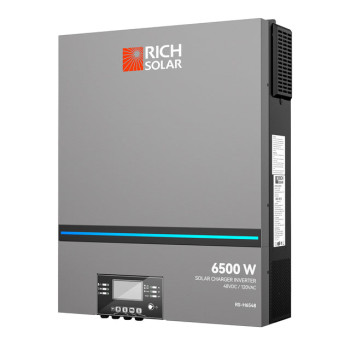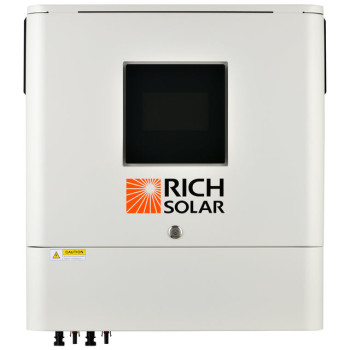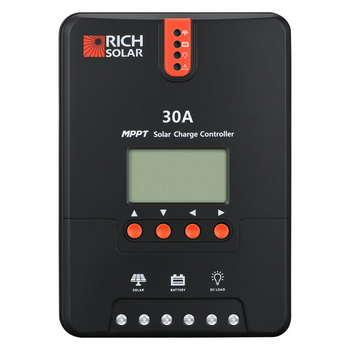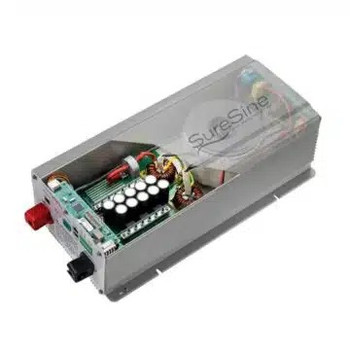Inverter/chargers
-

Ecoflow
$599.00Features Please kindly note that the EcoFlow Alternator Charger and the portable power station will be shipped separately. EcoFlow Alternator Charger is expected to arrive by the end of May. Charge while you drive, and stay powered up on...$599.00 -

Rich Solar
MSRP: $1,999.99$1,649.00FEATURES IP65 waterproof and dustproof makes the inverter available for various working conditions. Configurable color with the built-in RGB LED bar Built-in Wi-Fi for mobile monitoring (APP is required) Built-in alternative port for...MSRP: $1,999.99$1,649.00 -


Rich Solar
$319.993000 Watt Industrial Pure Sine Wave Inverter is ideal for large loads that require a clean, pure source of AC household power. FEATURES Electronic overload protection with automatic shutdown. Built-in internal backup DC fuse provides...$319.99 -

Rich Solar
FEATURES Pure sine wave inverter Configurable color with the built-in RGB LED bar Built-in Wi-Fi for mobile monitoring (APP is required) Supports USB On-the-Go function Built-in anti-dusk kit Detachable LCD control module with... -


Rich Solar
6500 Watt Industrial Pure Sine Wave Inverter is ideal for large loads that require a clean, pure source of AC household power. FEATURES UL Certification Status indication with RGB lights Built-in Wi-Fi for mobile monitoring (Android/iOS... -


Rich Solar
MSRP: $139.99$129.99Features Automatically detects 12V or 24V DC system voltages. Compatible with various deep cycle battery options:Sealed, Gel, Flooded, and Lithium. Innovative MPPT technology with high tracking efficiency up to 99% and peak conversion...MSRP: $139.99$129.99 -


Morningstar Corporation
MSRP: $731.00$658.00Since 1993 the name Morningstar has been synonymous with industry-leading charge controllers, used in mission-critical applications around the world. With that heritage and reputation, “Morningstar of Inverters” has a very high...MSRP: $731.00$658.00 -


Morningstar Corporation
MSRP: $726.00$653.00Since 1993 the name Morningstar has been synonymous with industry-leading charge controllers, used in mission-critical applications around the world. With that heritage and reputation, “Morningstar of Inverters” has a very high...MSRP: $726.00$653.00 -


Morningstar Corporation
MSRP: $767.00$690.00Since 1993 the name Morningstar has been synonymous with industry-leading charge controllers, used in mission-critical applications around the world. With that heritage and reputation, “Morningstar of Inverters” has a very high...MSRP: $767.00$690.00 -


Morningstar Corporation
MSRP: $387.00$348.00Since 1993 the name Morningstar has been synonymous with industry-leading charge controllers, used in mission-critical applications around the world. With that heritage and reputation, “Morningstar of Inverters” has a very high...MSRP: $387.00$348.00 -


Morningstar Corporation
MSRP: $375.00$338.00Since 1993 the name Morningstar has been synonymous with industry-leading charge controllers, used in mission-critical applications around the world. With that heritage and reputation, “Morningstar of Inverters” has a very high...MSRP: $375.00$338.00 -


Morningstar Corporation
MSRP: $362.00$326.00Since 1993 the name Morningstar has been synonymous with industry-leading charge controllers, used in mission-critical applications around the world. With that heritage and reputation, “Morningstar of Inverters” has a very high...MSRP: $362.00$326.00
Inverter/chargers are devices that can convert direct current (DC) electricity, usually from a battery or other DC power source, into alternating current (AC) electricity that can be used to power household or industrial appliances. Additionally, they are capable of charging the battery or power source from an AC power source, such as a utility grid or generator.
Inverter/chargers typically include a DC-to-AC inverter that converts the DC power from the battery into AC power that can be used to power appliances or machinery. In addition, they also include a battery charger that can convert AC power from an external source into DC power to charge the battery. These two functions are combined into a single device, making it easier to manage and control the power system.
The operation of an inverter/charger is controlled by a microprocessor that monitors the battery and power inputs, and switches between the inverter and charger functions as needed. When the battery voltage drops below a certain level, the inverter/charger automatically switches to the charging mode and begins to charge the battery from the external AC power source. Similarly, when the battery is fully charged or when AC power is available, the device switches to the inverter mode and converts the DC power from the battery into AC power for use.
Inverter/chargers are commonly used in off-grid or remote power systems, where a reliable and efficient power supply is necessary. They are also used in backup power systems, such as emergency generators, where they can provide a seamless transition between battery power and grid power during power outages. Inverter/chargers come in a variety of sizes and power ratings to suit a range of applications, from small home power systems to large commercial or industrial power systems.
Frequently Asked Questions About Inverter/chargers
A: An off-grid inverter/charger is a device that converts DC power from a battery bank into AC power for use in a home or business, while also providing the ability to charge the battery bank using AC power from a generator or grid connection.
A: The main benefit of using an off-grid inverter/charger is that it allows for a reliable and sustainable source of electricity in areas where grid power is not available or is unreliable. It also provides the ability to use renewable energy sources, such as solar or wind power, to power your home or business.
A: An off-grid inverter/charger typically includes an inverter, charger, and transfer switch in a single unit. Some models also include additional features, such as grid-tie capability, load management, and remote monitoring and control.
A: An inverter converts DC power from a battery bank into AC power for use in a home or business. A charger, on the other hand, converts AC power from a generator or grid connection into DC power to charge the battery bank.
A: Yes, an off-grid inverter/charger can be used in conjunction with renewable energy sources, such as solar panels or wind turbines, to provide a complete off-grid power solution.
A: Grid-tie capability allows an off-grid inverter/charger to connect to a utility grid and feed excess power back into the grid, which can result in lower energy bills and even the ability to earn credits for excess energy.
A: Load management is a feature of some off-grid inverter/chargers that allows the inverter to manage and prioritize loads in the event of a power outage or other situation where the battery bank is being used to power the home or business.
A: Yes, off-grid inverter/chargers can be used in homes or businesses with grid power as a backup power source in the event of a power outage.
